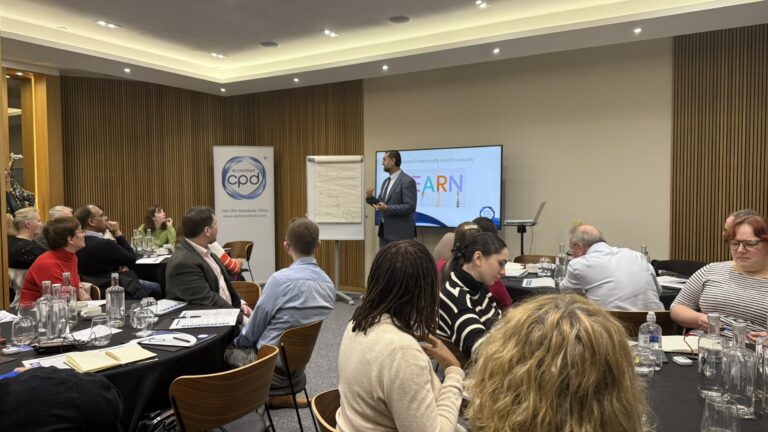CPDSO has seen hundreds of training organisations pivot to online learning, and we are extremely proud of all the creative ideas. Many people used to F2F (face to face) learning have been nervous about delivery and what they should be wearing. We have a few questions and answers about preferred backgrounds, plus what to wear for 1-2-1 sessions; as it is very hard to emulate what we would do in person, plus delegates are in a more relaxed dressing as they remote work.
Alexandra Wood, the first female tailor on Saville Row, a good colleague of CPDSO has kindly provided advice and tips for looking good on camera. The saying “You need to dress for the job you want not the job you are in” – this has never been more important.
Due to the impact that COVID-19 has had on the working world as we knew it, everyone has had to turn to a new solution being online meetings. It all happened in the blink of an eye and faster than we could have anticipated. Zoom were taking sales of over 200 million daily meeting participants, a significant increase to this time last year. It’s safe to say that the virus truly turned people’s heads to the practicality of this online meeting programme. Microsoft’s Skype also saw a 70% increase in its usage across the world. From boardroom meetings to exercise classes, there’s no doubt about it, we’ve all had to change the way we operate in our day to day working life. The question is how do we now dress for the occasion. We discuss:
Depending on which line of business you’re in, will make a significant difference to the way you dress. If you’re in the world of tech you’re likely to already dress more casually than those working in a corporate environment, so lucky for you there won’t be much change here for you. If you’re a lawyer holding online meetings, questions will arise such as – will you still need to wear a full suit?
Our customers who are in two different occupations entirely have different views based on how they usually dress for their work environment. It seems that not too much has changed and is very much business as usual, just in a changed environment.
“Many court hearings and trials are now going ahead remotely. Even though we are no longer physically in court rooms, I’ve found it important to dress with the same level of formality as for an in-person trial, as it impresses upon people that even though they may just be sat in their living rooms, they are taking part in very real (and often very serious) court proceedings. For meetings, I’ve also found that it’s best to dress smartly: it simply creates a good impression and shows everyone that you take their case seriously.”
Stuart Russell, Communications Director, Media & live production says: “My weekly webinars are hosting between 200-800 people so I’ll always wear a smart shirt for that. No jacket or tie though. For internal meetings I’ll wear a polo shirt at worst. I wouldn’t dream of conducting a meeting in a T-shirt!’’
After we took a poll on our Twitter, there was a clear 50 / 50 divide between men wearing casual clothing and still wearing their smart attire which is interesting.
When dressing for an in person meeting or online, how you wish to represent yourself should be key. Dressing smart is seen as sign of respect. As Tom Ford said: ‘’Dressing well is a form of good manners’’ and we here at Alexandra Wood tend to agree. How you show up to work in person shouldn’t be any different when working via an online system. We run through some of the key points to focus on that apply to both men and women:
Colour
Wear something that lifts your skin tone. Note that the colour black tends to make you look less trustworthy. The salesman wearing all black will make a lot of sales, but no friends! It radiates authority, but creates fear in the process. Blue tends to be the winning colour psychologically, displaying trust, honesty and authority. It has therefore been proven to increase sales and positive relationships. Wear a fresh blue shirt, blue suit or a blue sweater with a crisp white shirt on. When in doubt: keep things simple.
Practicality
Work with what works. Knitwear is fine but make sure it’s smart and un-crinkled. Shirts are great if you’re disciplined enough to keep them looking crisp. It’s fine to wear the first button or two open but no more or you’ll look too nonchalant. Roll necks tend to work well as they look smart or choose a plain, smart T-shirts are even fine now that it’s getting warmer but only if you’re in a creative field of work. Just make sure it’s fitted, without logos and of a good quality.
Check your scenery
The person you’re talking to will likely be looking just as much around you, as at you, so make sure your surroundings also represent who you are. There’s no need to re-decorate just yet but do be mindful that you’ve got a relatively plain background and needless to say make sure your room is smart and tidy. First impressions count and the ones thereafter too.
Camera checks
Make sure your web camera is pointing down a touch, rather than up. No one really wants to see your ceiling. Look at the camera and not at the person you’re talking to. By looking at the camera, it looks like you’re talking directly to the person. It does feel slightly odd, as the natural inclination is to look at the person.
Lighting
Make sure you’re not sat with a window behind you or the light will glare through and make it difficult for the person on the other end to see you plus it’s distracting. If you want to go a step further you can buy a lightbox so that you look gleaming.
Sound
Make sure you’re in a room that is quiet and doesn’t echo. A room with books or furnishings is ideal, so that the sound quality is good.
Round up
Think about how you wish to represent yourself and try to wear similar clothes to which you’d usually wear to work. Meetings after the crisis may continue to be performed this way for safety and practicality, so this will be useful for now and the future. But most of all, we wish you all well.
www.alexandrawoodbespoke.co.uk







